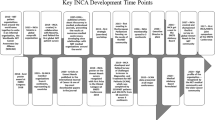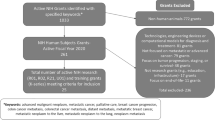Abstract
The brain tumor community is a unique, underserved population that has not seen significant improvements in survival over the last four decades. In the search for effective treatments for brain tumors, nonprofit patient advocacy organizations identify and fill the gaps that the for-profit sector and the government have not addressed or cannot address. Although many articles have been written on the roles of patient advocacy groups in general, or in targeted areas such as clinical trial recruitment, none have looked at the brain tumor community specifically. This review looks at the literature on patient advocacy groups and provides specific examples of brain tumor advocacy organizations that offer these services. It examines the evolution of the role of these organizations over time, and how that has been reflected in the programs and services provided. This is a collaborative effort to highlight programs and services across multiple patient advocacy organizations.
Similar content being viewed by others
References
Papers of particular interest, published recently, have been highlighted as: • Of importance •• Of major importance
Howlader N, Noone AM, et al, editors. SEER cancer statistics review, 1975-2010. National Cancer Institute, Bethesda. Available at http://seer.cancer.gov/csr/1975_2010/. Accessed 18 Nov 2013.
Dolecek TA, Propp JM, Stroup NE, Kruchko C. CBTRUS statistical report: primary brain and central nervous system tumors diagnosed in the United States in 2005–2009. Neuro Oncol. 2012;14 Suppl 5:v1–49. doi:10.1093/neuonc/nos218. Understanding brain tumor burden is important to comprehend the impact of the disease and how it compares with other rare and not so rare diseases.
Sulik G, Cameron C, Chamberlain R. The future of the cancer prevention workforce: why health literacy, advocacy, and stakeholder collaborations matter. J Cancer Educ. 2012;27(2):165–72. Pages 168–169 highlight how advocacy impacts policy development in cancer prevention.
Quale D, Droller M. Cancer patient advocacy: new opportunities for treatment advances. Urol Oncol. 2007;25(4):351–2.
Collyar D. An essential partnership: patient advocates and cooperative groups. Semin Oncol. 2008;35(5):553–5.
Walsh J. The evolving role of COPD patient advocacy organizations for COPD. J Thorac Dis. 2012;4(6):676–80. The author reveals the programmatic structure of the COPD Foundation within the areas of education, public policy, and research.
Koay P, Sharp R. The role of patient advocacy organizations in shaping genomic science. Annu Rev Genomics Hum Genet. 2013;14:570–95. This is an overview the evolution of the definition of patient advocacy organizations. The authors explore the relationships between patient advocacy groups and researchers and how they might change in the face of increasing importance of genomic science.
La Fargue M. Policy and advocacy in the quest for effective translational breast care research. Breast. 2010;19(4):303–6.
Tsigas E, Magee L. Advocacy organisations as partners in pre-eclampsia progress: patient involvement improves outcomes. Best Practi Res Clin Obstet Gynaecol. 2011;25(4):523–36. The authors present a thorough analysis of the different roles that advocacy organizations play in the advancement of the health care system.
Rabeharisoa V. The struggle against neuromuscular diseases in France and the emergence of the “partnership model” of patient organisation. Soc Sci Med. 2003;57(11):2127–36.
Black A, Baker M. The impact of parent advocacy groups, the Internet, and social networking on rare diseases: the IDEA League and IDEA League United Kingdom example. Epilepsia. 2011;52(Suppl s2):102–4. This article highlights the broad scope of support services that advocacy groups can offer with evolving communication technologies, such as the Internet.
Dunkle M, Pines W, Saltonstall PL. Advocacy groups and their role in rare diseases research. Adv Exp Med Biol. 2010;686:515–25.
Hall J. The role of patient advocacy/parent support groups. S Afr Med J. 2013;103(12):1020–2. This article highlights the origins of patient advocacy groups. The author provides details on what types of tasks patient advocacy groups perform.
Boon W, Broekgaarden R. The role of patient advocacy organisations in neuromuscular disease R&D – the case of the Dutch neuromuscular disease association VSN. Neuromusc Disord. 2010;20(2):148–51.
Wood J, Sames L, Moore A, Ekins S. Multifaceted roles of ultra-rare and rare disease patients/parents in drug discovery. Drug Discov Today. 2013;18(21):1043–51. This article highlights the role of patients and advocates in drug discovery and development. The authors present an alternative model for pharmaceutical research via patient advocacy channels.
Jarvis L. Orphans find a home. Chem Eng News. 2013;91(19):10–23. This special report provides a very detailed case study of how patients are able to impact their own treatment and in turn shape the future of the health care system. In addition, multiple areas of drug research are tied into one narrative: the business of drug development, the regulatory framework, and the ability of ptients to impact these domains.
Wexler N. Huntington's disease: advocacy driving science. Annu Rev Med. 2012;63:1–22. This article reveals the history of researching Huntington’s disease from the perspective of the patient and the researcher. In addition, the article shows the impact that one organization can have on the evolution of the science and development of treatments.
Tambuyzer E. Rare diseases, orphan drugs and their regulation: questions and misconceptions. Nat Rev Drug Discov. 2010;9(12):921–9.
Rieger P, Moore P. Professional organizations and their role in advocacy. Semin Oncol Nurs. 2002;18(4):276–89.
Terry S, Terry P, Rauen K, Uitto J, Bercovitch L. Advocacy groups as research organizations: the PXE International example. Nat Rev Genet. 2007;8(2):157–64.
Rose S. Patient advocacy organizations: institutional conflicts of interest, trust, and trustworthiness. J Law Med Ethics. 2013;41(3):680–7. This article provides the definition of patient advocacy organizations.
Ayme S, Kole A, Groft S. Empowerment of patients: lessons from the rare diseases community. Lancet. 2008;371:2048–51.
American Brain Tumor Association. Brain tumor symptoms, treatment, support, research | American Brain Tumor Association. http://abta.org (2013). Accessed 18 Dec 2013.
Musella Foundation for Brain Tumor Research & Information. Musella Foundation. http://www.virtualtrials.com/musella.cfm (2013). Accessed 18 Dec 2013.
Accelerate Brain Cancer Cure. Accelerate Brain Cancer Cure | we’re a Washington DC-based venture philanthropy organization that drives cutting-edge research and treatments for brain cancer. http://abc2.org (2013). Accessed 18 Dec 2013.
The Brain Tumour Charity. The Brain Tumour Charity | home. http://www.thebraintumourcharity.org (2013). Accessed 16 Dec 2013.
Imerman Angels. Imerman Angels | one-on-one cancer support: connecting cancer fighters, survivors & caregivers. http://www.imermanangels.org (2013). Accessed 16 Dec 2013.
Pediatric Brain Tumor Foundation. Pediatric Brain Tumor Foundation - homepage. http://www.curethekids.org (2013). Accessed 16 Dec 2013.
National Brain Tumor Society. National Brain Tumor Society. http://www.braintumor.org (2013). Accessed 16 Dec 2013.
National Cancer Institute. Drugs approved for brain tumors - National Cancer Institute. http://www.cancer.gov/cancertopics/druginfo/braintumors (2013). Accessed Dec 16 2013.
Kaiser J. Court decides tissue samples belong to university, not patients. Science. 2006;312(5772):346.
Truog R, Kesselheim A, Joffe S. Paying patients for their tissue: the legacy of Henrietta Lacks. Science. 2012;337(6090):37–8. This article provides insight on the debate of property rights in human tissue.
Vivekanandarajah A, Krishnarasa B, Mourad M, Aoun N, Odaimi M. Achievement of three year remission with bevacizumab and irinotecan in recurrent glioblastoma multiforme: a case report. Clin Med Insights Oncol. 2011;5:15–21.
Brain Tumour Foundation of Canada. Brain Tumour Foundation of Canada: home. http://www.braintumour.ca (2013). Accessed 16 Dec 2013.
Kessel M. The problems with today's pharmaceutical business - an outsider's view. Nat Biotechnol. 2011;29(1):27–33.This article provides an overview of the drug development process and its limitations.
Baxter K, Horn E, Gal-Edd N, Zonno K, O’Leary J, Terry PF, et al. An end to the myth: there is no drug development pipeline. Sci Transl Med. 2013;5(171):1–4. The authors highlight why the current drug development models no longer work and provide an alternative “network” approach to fuel drug development.
Panofsky A. Generating sociability to drive science: patient advocacy organizations and genetics research. Soc Stud Sci. 2011;41(1):31–57. This article provides a social science perspective on how patient advocacy organizations engage other important resources in researching a treatment for a disease. The author introduces the concept of “sociability” as a tool that patient advocacy organizations can use to drive research.
Kitano H. Systems biology: a brief overview. Science. 2002;295(5560):1662–4.
Compliance with Ethics Guidelines
Conflict of Interest
Carl Cadogan, Jonny Imerman, and Sarah Lindsell declare that they have no conflict of interest.
Michele Rhee is the Director of Program Initiatives at the National Brain Tumor Society.
Paulius Mui is the Executive/Program Assistant at the National Brain Tumor Society.
Lainey Titus Samant is the Associate Director of Public Policy at the National Brain Tumor Society.
Human and Animal Rights and Informed Consent
This article does not contain any studies with human or animal subjects performed by any of the authors.
Author information
Authors and Affiliations
Corresponding author
Additional information
This article is part of the Topical Collection on Neuro-Oncology
Rights and permissions
About this article
Cite this article
Rhee, M., Mui, P., Cadogan, C. et al. The Role of Brain Tumor Advocacy Groups. Curr Neurol Neurosci Rep 14, 442 (2014). https://doi.org/10.1007/s11910-014-0442-z
Published:
DOI: https://doi.org/10.1007/s11910-014-0442-z




